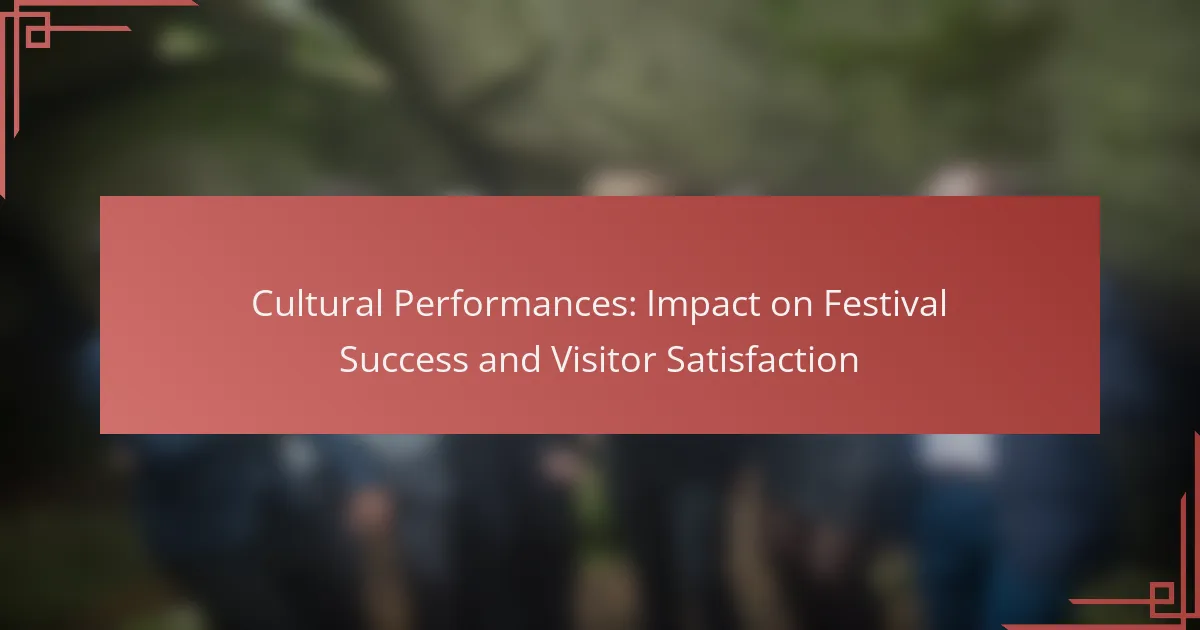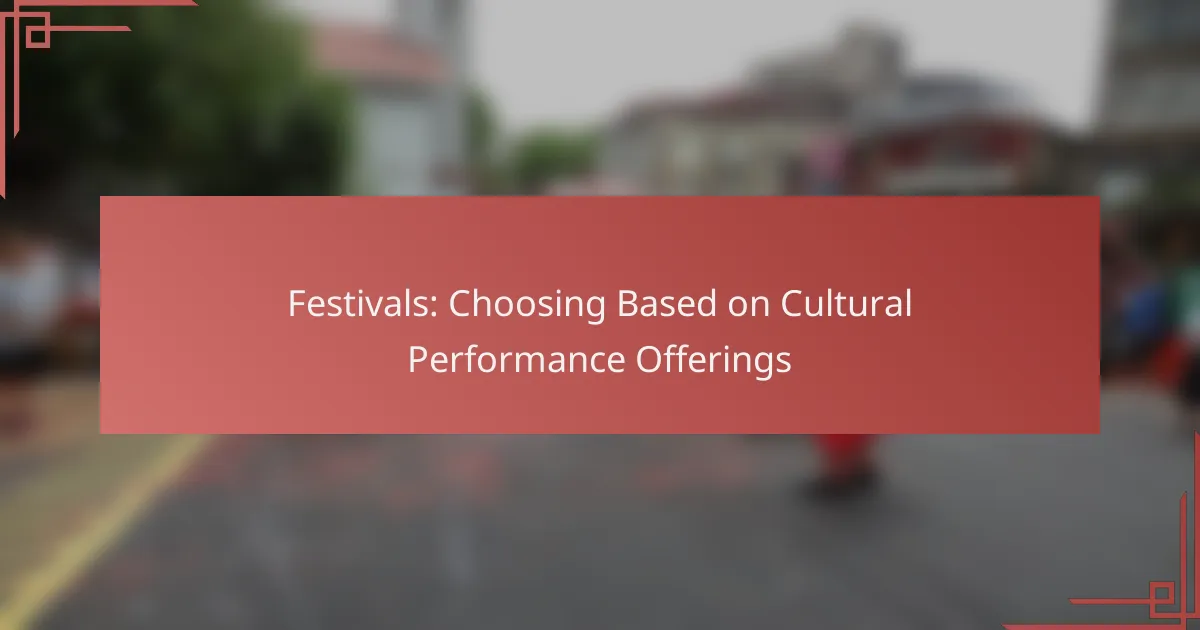Cultural performances are essential for nurturing community identity and fostering a sense of belonging among residents. They celebrate local heritage, create shared experiences, and serve as living archives that preserve the values and traditions of a community. Additionally, these events contribute to economic development by enhancing tourism and supporting local businesses, thereby strengthening social bonds and cultural pride.

How do cultural performances impact community identity in the United States?
Cultural performances play a vital role in shaping community identity in the United States by fostering a sense of belonging and continuity among residents. These events not only celebrate local heritage but also create shared experiences that strengthen social bonds.
Strengthening local traditions
Cultural performances serve as a platform for preserving and promoting local traditions. Events such as folk festivals, parades, and community theater showcase unique customs and practices that reflect the history of the area. For instance, Native American powwows and Southern bluegrass festivals highlight the rich cultural tapestry of their respective communities.
By participating in these performances, community members actively engage with their heritage, ensuring that traditions are passed down through generations. This engagement helps to maintain a distinct local identity that can be recognized and celebrated.
Fostering community engagement
Cultural performances encourage community engagement by bringing people together for shared experiences. Events like concerts, dance recitals, and cultural fairs attract diverse audiences, fostering interactions among individuals from different backgrounds. This mingling can lead to stronger community ties and a greater understanding of one another’s cultures.
Moreover, these performances often involve local volunteers and artists, providing opportunities for residents to contribute to their community. This involvement not only enhances the event but also instills a sense of pride and ownership among participants.
Enhancing cultural pride
Participating in cultural performances can significantly enhance cultural pride within a community. When residents celebrate their unique cultural expressions, they reinforce their identity and heritage. Events like Mardi Gras in New Orleans or the Albuquerque International Balloon Fiesta highlight local customs and foster a sense of pride among participants and spectators alike.
Additionally, showcasing cultural performances can attract tourism, which further boosts local economies and encourages residents to take pride in their community’s uniqueness. This pride can lead to increased advocacy for preserving cultural heritage and supporting local artists and performers.
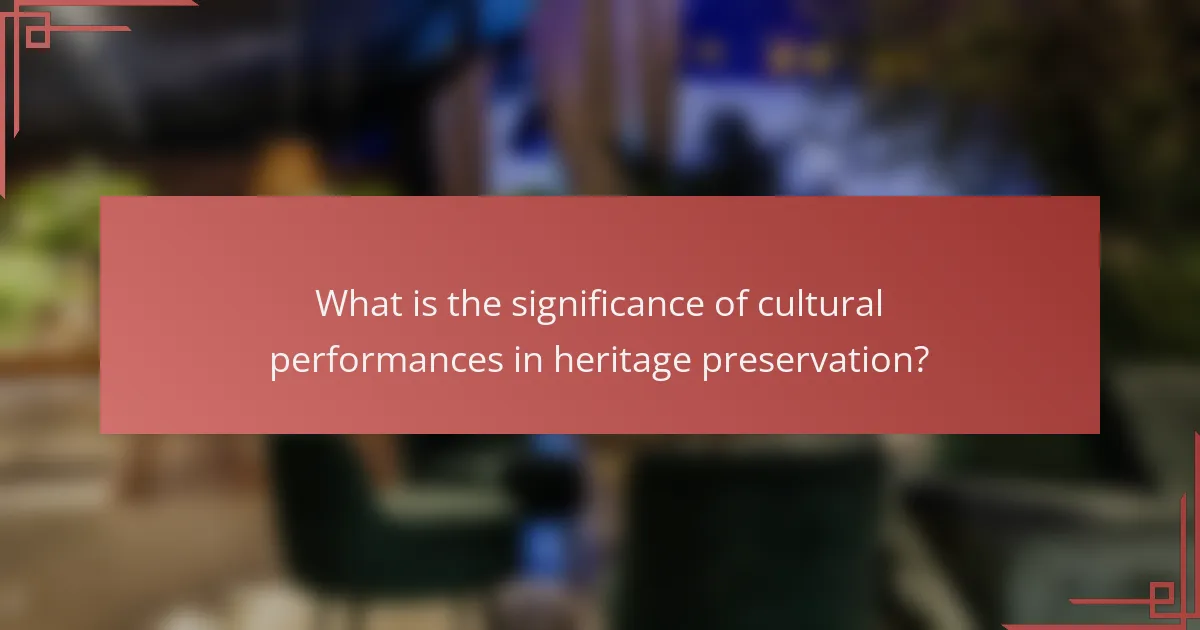
What is the significance of cultural performances in heritage preservation?
Cultural performances play a crucial role in heritage preservation by embodying and transmitting the values, traditions, and stories of a community. They serve as living archives, ensuring that cultural identities are maintained and celebrated across generations.
Documenting historical narratives
Cultural performances are vital for documenting historical narratives, as they often reflect significant events, beliefs, and practices of a society. Through storytelling, music, dance, and theater, these performances capture the essence of cultural heritage, allowing audiences to connect with their history.
For example, traditional dances may reenact historical battles or rituals, providing insight into the community’s past. This documentation helps preserve not only the stories but also the languages and dialects associated with these narratives, which are essential for cultural continuity.
Promoting intergenerational knowledge transfer
Intergenerational knowledge transfer is facilitated through cultural performances, as they often involve participation from both older and younger members of a community. This interaction fosters a sense of belonging and encourages younger generations to learn about their heritage in an engaging manner.
Workshops and community events that include performances allow elders to share their skills and stories, ensuring that traditional practices are not lost. For instance, a community might host a festival where elders teach younger participants traditional crafts or music, reinforcing cultural bonds and identity.
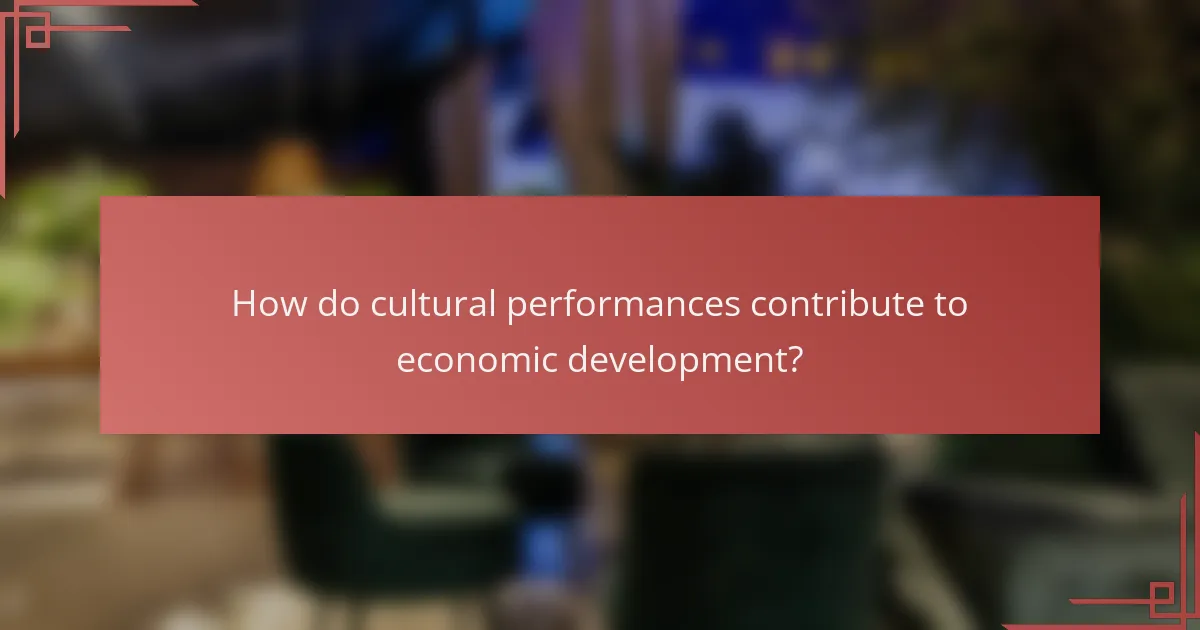
How do cultural performances contribute to economic development?
Cultural performances play a vital role in economic development by enhancing tourism, creating job opportunities, and supporting local businesses. These activities not only generate revenue but also foster community engagement and cultural pride.
Attracting tourism
Cultural performances serve as a significant draw for tourists, who seek authentic experiences that reflect local traditions. Events such as music festivals, dance shows, and theater productions can attract visitors from both domestic and international markets, boosting local economies.
For example, a traditional dance festival might increase hotel bookings and restaurant patronage in the area, leading to a surge in economic activity. Regions known for their cultural events often see a steady influx of tourists, especially during peak seasons.
Creating job opportunities
The cultural performance sector creates various job opportunities, ranging from performers and technicians to event organizers and hospitality staff. These roles can be part-time or full-time, providing flexible employment options for local residents.
Moreover, as cultural events grow in popularity, they can lead to the establishment of new businesses, such as production companies and marketing agencies, further expanding job prospects in the community.
Supporting local businesses
Cultural performances can significantly benefit local businesses by increasing foot traffic and visibility. When events are held, nearby shops, restaurants, and service providers often experience a boost in sales due to the influx of attendees.
Collaboration between cultural organizations and local businesses can enhance this effect. For instance, local artisans might sell their crafts at performance venues, creating a symbiotic relationship that supports both cultural heritage and economic growth.
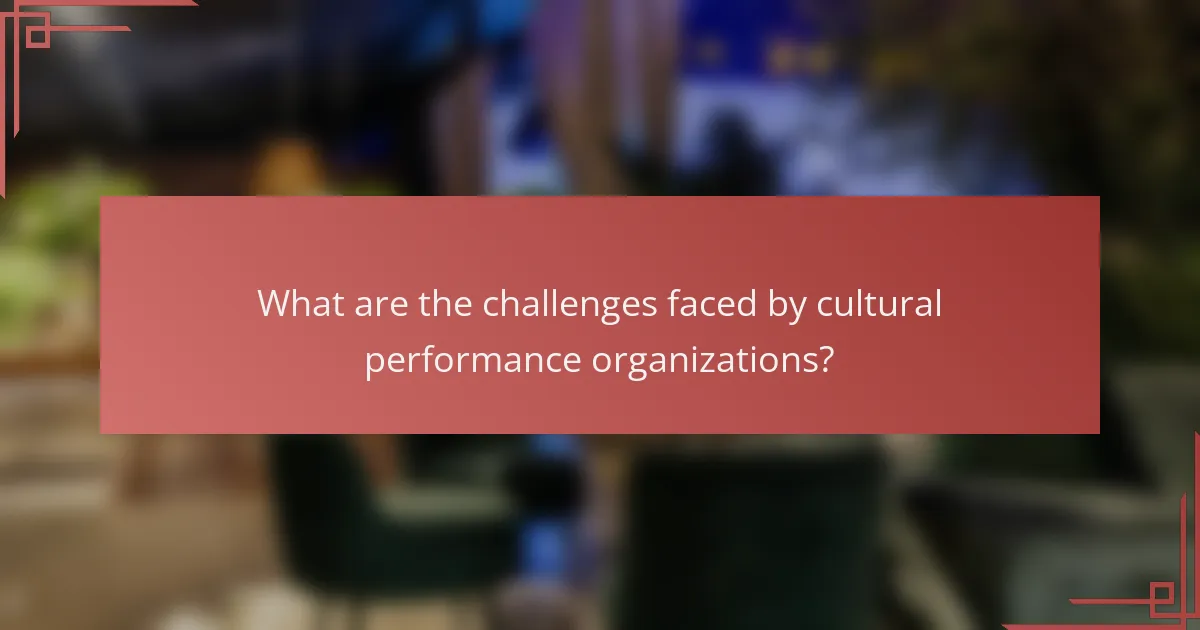
What are the challenges faced by cultural performance organizations?
Cultural performance organizations encounter several significant challenges that can hinder their operations and impact. Key issues include a lack of funding, difficulties in engaging audiences, and increasing competition from digital entertainment platforms.
Lack of funding
Many cultural performance organizations struggle with insufficient financial resources, which limits their ability to produce high-quality events. Funding often comes from a mix of ticket sales, grants, and donations, but these sources can be unpredictable.
Organizations should explore diverse funding avenues, such as crowdfunding, partnerships with local businesses, or applying for government grants. Establishing a strong donor base can also help stabilize finances over time.
Audience engagement issues
Engaging audiences is crucial for the survival of cultural performance organizations, yet many face challenges in attracting and retaining attendees. Factors such as changing demographics and shifting interests can impact audience turnout.
To improve engagement, organizations can utilize social media for outreach, create interactive experiences, and offer educational programs that connect performances to community interests. Tailoring marketing efforts to specific demographics can also enhance audience connection.
Competition from digital entertainment
Cultural performance organizations increasingly compete with digital entertainment options, such as streaming services and online gaming, which offer convenience and variety. This competition can divert potential audiences away from live performances.
To counter this, organizations should emphasize the unique aspects of live events, such as the communal experience and the opportunity for direct interaction with artists. Offering hybrid models that combine live and digital elements can also attract a broader audience.
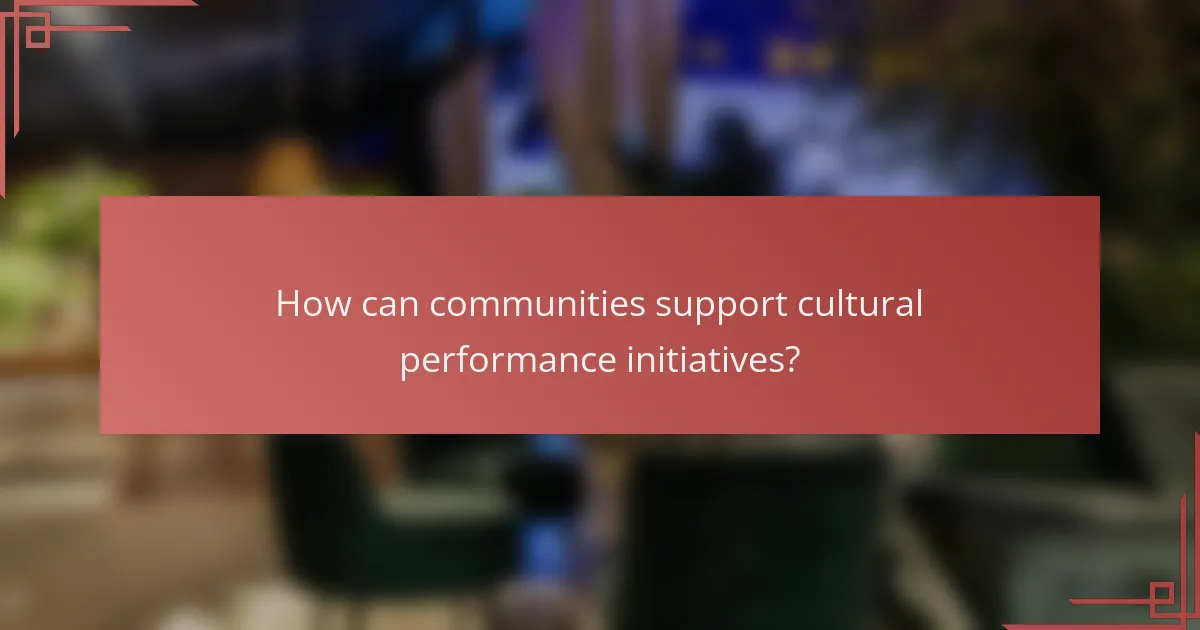
How can communities support cultural performance initiatives?
Communities can support cultural performance initiatives by actively participating in funding, forming partnerships, and engaging volunteers. These efforts help sustain and promote local arts, ensuring cultural heritage is preserved and celebrated.
Funding opportunities
Securing funding is crucial for cultural performance initiatives. Communities can explore various sources, including government grants, private donations, and crowdfunding platforms. Local arts councils often provide financial support, so researching available grants can yield significant resources.
Consider organizing fundraising events such as benefit concerts or art auctions. These not only raise money but also increase community engagement and awareness of cultural performances.
Partnerships with local businesses
Forming partnerships with local businesses can enhance cultural performance initiatives. Businesses can sponsor events, provide venues, or offer in-kind donations, such as food and supplies. This collaboration fosters a sense of community and can lead to mutual benefits, such as increased foot traffic for businesses and greater visibility for cultural events.
Engaging businesses in promotional efforts can also amplify outreach. For example, businesses can feature events in their marketing materials or social media, helping to attract larger audiences.
Volunteer programs
Volunteer programs are essential for the success of cultural performance initiatives. They provide valuable manpower for organizing events, managing logistics, and promoting performances. Communities can recruit volunteers through local schools, community centers, and social media platforms.
Offering training and development opportunities for volunteers can enhance their skills and commitment. Recognizing their contributions through appreciation events or certificates can also encourage ongoing participation and strengthen community ties.


